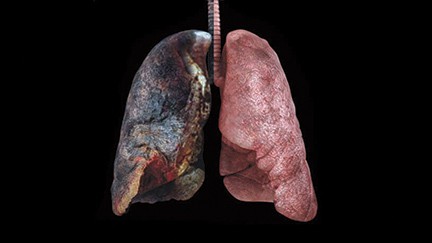The future of cab filtration, HVAC design, and operator respiratory health
By Jeff Moredock
The case for the osha silica regulation and its impact on mobile HVAC design
“Why does the OSHA Silica regulation exist?” To protect workers from the dangerous effects of respirable crystalline silica. Silica, which comprises roughly 29% of the earth’s surface, interacts with earth-moving equipment whenever rock is crushed, abraded, or cut. According to the National Institute for Health, “Respirable crystalline silica . . . was reclassified in 1997 as a Group One carcinogen by the International Agency for Research on Cancer (IARC).” For us non-medical types, this means there is sufficient evidence suggesting respirable crystalline silica causes cancer in humans. See Figure 1.

Figure 1: This image of human lungs shows a healthy lung on right and one with silicosis on left. OSHA requires employers to protect their workers from exposure to RCA (respirable crystalline silica), tiny particles that can travel deep into workers’ lungs and cause silicosis, an incurable and sometimes deadly lung disease. Photo credit: iqpowertools.com
Silica exposure, while operating from within a machine cab, is addressed in the regulation. Specific engineering controls, which include a functioning HVAC system, continuous cab pressurization and a minimum level of filtration efficiency (95% on 0.3 to 10 µ particles e.g. MERV 16), are requirements of the regulation.
Merv 16 explained
Many mobile HVAC manufacturers and technicians are not familiar with the Minimum Efficiency Rated Value (MERV) rating system. ASHRAE (American Society of Heating, Refrigerating and Air-Conditioning Engineers) is an association that provides, among other things, a standard testing and rating system (ASHRAE 52.2) for filters produced for commercial buildings and homes. Under its rating system, the lowest efficiency filters are rated MERV 1, while the highest efficiency filters are rated MERV 16.
Why did OSHA apply a standard used for commercial building filtration to an operator cab on a piece of heavy equipment? While far from a perfect fit, the ASHRAE 52.2 testing and rating standard proved to be the best measure available. The test results show a range of particle sizes and the efficiency of the filter within each particle size range.
The National Institute for Occupational Safety and Health (NIOSH) studied cab filtration. One conclusion was, with few exceptions, that filtration used on operator cabs allowed significant concentrations of dust to aggregate in the operator cab. Up to that point, the focus of HVAC filtration was to keep large contaminants and objects off the evaporator core. The filtration acted more as a barrier to fingers, leaves, shop towels, and anything else in the operator cab that could be drawn into the recirculation system.
Filters are often not marked according to any standard rating system, and are often simply promoted as good, better, and best. In the heavy equipment industry, filtration efficiency is determined through the use of an engine filter efficiency test. This test standard produces an efficiency rating based on testing with ISO fine or course test dust, and includes the dust holding capacity of the filter.
Engines require efficient air filtration to keep dust from entering the engine, contaminating the oil, and causing engine wear. When the engine oil gets contaminated it is changed. Human lungs, on the other hand, are negatively affected by small particles and are not easy to change or clean. Therefore, the efficiency of the filter had to improve dramatically to be effective in protecting the machine operator. This necessitated a change in filter testing standards to ensure that the filter is efficient enough for human respiratory environments.
(Continue reading)
